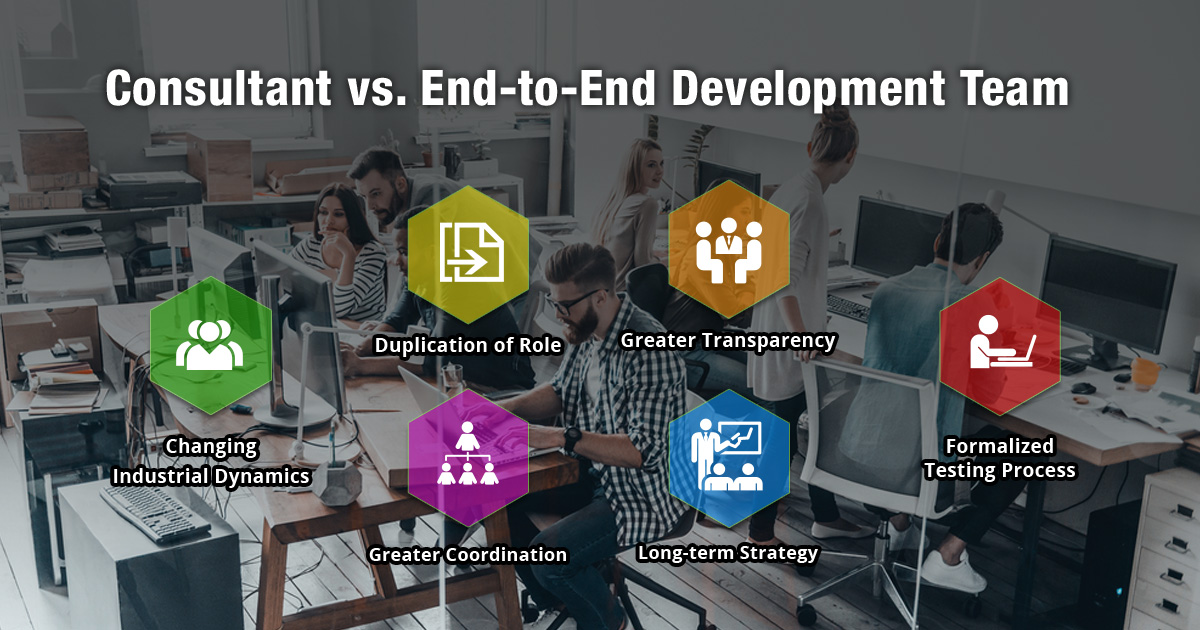In today’s business world, Information Technology is often a part of company’s strategic planning. This means IT directly affects business models, as it is not just used as a process enabler.
The question often arises: How can a company stay on the cutting edge with the latest in IT technology? How can an organization then execute these technologies?
Organizations have long battled the question whether they should hire a consultant or an end-to-end development team. Right now, with changing IT ecosystem, not only have technologies changed but so has the entire structure of the industry. More and more IT companies have built in-house 360° consulting capabilities to better understand their customer’s needs. This technology provides assistance for the business goals and needs.
It’s beneficial to stay aware of the latest industrial developments, to make informed decisions about an organization’s IT needs for all its Business Intelligence Solutions.

Ways End-to-End Development Teams Outrun the Need for a Consultant
With changing IT ecosystem, not only have technologies changed but so has the entire structure of the industry. More and more IT companies have built in-house 360° consulting capabilities to better understand their customer business. This technology provides assistance for business goals and needs.
Following are some of the top reasons which are why end-to-end development teams outrun the need for a consultant:
1. Changing industrial dynamics
The rise of end-to-end development teams represents one of the most major shifts in recent years in rapidly changing industry dynamics. These teams have developed to include competence in business technology consulting in addition to their technical expertise in software development. In the past, businesses would frequently employ independent consultants to advise them on what tools or products to utilise and assist them in assembling an execution team. However, this strategy is getting older and older.
Nowadays, end-to-end development teams can provide consulting services to help organizations understand their business needs and provide tailor-made solutions that meet their specific requirements. These teams have a deep understanding of the latest technologies and how they can be leveraged to drive business success. They can help organizations stay ahead of the curve and make informed decisions when it comes to implementing new technologies.
The shift towards end-to-end development teams is not limited to the software development sector. It has become a trend across industries, as organizations seek to streamline their operations and reduce overhead costs. By hiring a single team to handle all aspects of a project, organizations can eliminate the need to manage multiple vendors and ensure a higher level of cohesion and communication throughout the project lifecycle.
2. Duplication of the role
Along with the core IT team of the organization, the end-to-end development team works hand-in-hand to work on security, scalability, maintainability, ease of usage and performance. Companies rely on Business Intelligence Service Providers for many reasons.
End-to-end development teams work directly with the organization to gain an in-depth understanding of their business needs, objectives, and goals. This enables them to tailor their services and solutions to meet the specific requirements of the organization. They collaborate with the organization's IT team to design, develop, implement, and maintain custom IT solutions that meet the highest standards of quality, reliability, and scalability.
In contrast, consultants act as project managers who coordinate between different teams, monitor the progress of the project, and ensure that the project is completed on time and within budget. While they may have some level of expertise in the field of IT, their primary role is to manage the project and ensure that it meets the requirements of the client organization. However, they may not have the same level of in-depth knowledge and understanding of the organization's business needs as the end-to-end development team.
With sophisticated collaboration tools and regular reporting structures, the entire process gets automated and transparent. With a project manager already existing from the development team’s end, this is nothing but a duplication of the role and increasing unnecessary expenditure attached with little or no extra value added.
3. Greater transparency
Any organisation must be transparent, but this is necessary when it comes to the technological foundation of the business. In earlier days, businesses would frequently use consultants to manage their IT initiatives, which could cause problems with reporting and communication. End-to-end development teams increase project transparency by allowing the core IT team to communicate directly with the development team.
Having the core IT team directly involved in the project means that they have a better understanding of what is going on and can have more control over the project's outcome. This approach eliminates the need for an extra layer of reporting and communication, which can often lead to information loss and delays in decision-making. With greater transparency, organizations can ensure that their IT projects are completed efficiently and effectively.
Furthermore, having a consultant instead of directly interacting with the development team can lead to a constant dependency on the consultant. This dependency can result in a major chunk of important data that never reaches the organization's core IT team. This hierarchical information loss can lead to a lack of transparency and, ultimately, poor decision-making. By having an end-to-end development team, organizations can ensure that all important data is communicated and that the project's progress is transparent.
4. Formalized Testing Process
Traditionally, consultants were responsible for working closely with development teams to detect and fix bugs during the testing process. However, with the evolution of modern software development practices, end-to-end development teams have adopted a formalized testing process that eliminates the need for external consultants to redo the testing process.
The end-to-end development teams of today have a comprehensive testing process in place, which includes written test cases, regular regression testing, and bug detection from the very beginning of the project. These tests are conducted after every step of the development process, ensuring that any potential bugs are identified and addressed early in the development lifecycle.
This formalized testing process has several advantages over the traditional approach of relying on consultants for testing. Firstly, it saves time and resources by eliminating the need for external consultants to redo the testing process. Secondly, it ensures that the testing process is consistent and reliable, as the end-to-end development team is intimately familiar with the codebase and testing requirements. Finally, it allows for greater accountability, as the development team is responsible for the quality of the code and the success of the project.
5. Greater Coordination
Any project must have effective coordination to be successful, but software development is especially dependent on it. Compared to consultants, end-to-end development teams provide better coordination and collaboration since they are qualified to offer a full range of services, comprising management of projects, delivery management, and business technology consulting knowledge.
End-to-end development teams typically have delivery managers and project managers who oversee the entire development process, from requirement gathering to project delivery. Delivery managers are responsible for managing their teams and ensuring timely deliveries, while project managers conduct various meetings with the client firm, giving demos and taking feedback.
Having both these roles in-house allows for better coordination and communication between the development team and the client firm, which ultimately leads to a more successful project outcome.
On the other hand, consultants often act as intermediaries between the client firm and the development team, which can result in miscommunication and delays. They may take feedback from the client firm and then hand it over to the third-party team executing the project, adding an extra step in the coordination process.
6. Long-term strategy
End-to-end development teams offer a long-term perspective and are well-equipped to handle the entire software development and maintenance process. This enables them to understand the needs and requirements of the client organization more comprehensively, resulting in better decision-making and long-term planning.
These teams have a vested interest in ensuring the success of the project and the long-term success of the client organization. They are focused on building a strong relationship with the client and are committed to providing quality services and solutions. This long-term approach enables the teams to work with the client organization in a more collaborative and effective manner.
Consultants, on the other hand, are often brought in for short-term assignments and may not have a long-term perspective on the client organization's needs and requirements. They may not be able to provide the same level of expertise and guidance as an end-to-end team, who are committed to understanding the client's business and providing solutions that are in sync with their long-term goals.
Conclusion
Rather than the above-mentioned reasons, end-to-end development teams are often more cost-effective than consultants. Hiring developers to handle the entire project is usually less expensive than hiring several consultants to handle different tasks. Additionally, end-to-end development teams often have more predictable pricing structures, which can help clients plan their budgets more effectively.
Call us at 484-892-5713 or Contact Us today to know more details about the Reasons Why End-to-End Development Teams are Winning Over Consultants.


